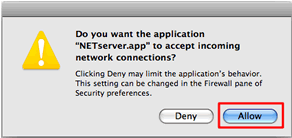Apache's configuration allows access to be restricted by IP address in both the main configuration file, virtualhost directives and.htaccess files. It can be useful to deny access to specific IP addresses, for example to keep a bad robot out; and it can equally be useful to deny access to all IP addresses but allow a select few in, for example to restrict access for a specific area of a. A list of MAC Addresses to deny from this pool. If a MAC address is in the deny list, then all others are allowed. It is best to use a combination of allow and deny to get the desired result, such as: In the main pool, leave allow blank and deny aa:bb:cc. Then in the VoIP pool, allow aa:bb:cc. If that extra step is not taken to allow the MAC. MAC (Media Access Control) is a unique identity to any IP devices. So, using MAC address, you can easily prevent unauthorized access to your router. MikroTik router provides various ways by which you can easily filter MAC address of any IP device and allow internet access to this device.
- Solved: MAC deny or allow lists. This topic has been deleted. Only users with topic management privileges can see it. PM13 last edited by PM13.
- One of the simplest fixes in this case is to use the 'hosts allow' and 'hosts deny' options in the Samba smb.conf configuration file to only allow access to your server from a specific range of hosts. An example might be: hosts allow = 127.0.0.1 192.168.2.0/24 192.168.3.0/24 hosts deny = 0.0.0.0/0.
- Use these steps to enable the application firewall: Choose System Preferences from the Apple menu. Click Security or Security & Privacy. Click the Firewall tab. Unlock the pane by clicking the lock in the lower-left corner and enter the administrator username and password. Click 'Turn On Firewall' or 'Start' to enable the firewall.
- When you add a Gmail account to Outlook you are prompted to Allow or Deny Microsoft Apps & Services. When you go to choose the Allow button, it's greyed out and not possible to proceed. This issue is fixed in Version 2003 Build 2. Until you are able to update to the fixed build, please use the following workarounds.
Safari User Guide
In the Safari app on your Mac, use Websites preferences to customize how you browse individual websites. To change these preferences, choose Safari > Preferences, then click Websites.

The settings you can customise (such as Reader and Content Blockers) are listed on the left.
To apply a setting to a website on the right, first select the setting, then choose the option you want from the pop-menu next to the website.
Option | Description | ||||||||||
|---|---|---|---|---|---|---|---|---|---|---|---|
Reader |
| ||||||||||
Content Blockers |
| ||||||||||
Auto-Play |
| ||||||||||
Page Zoom | Choose a percentage of zoom to make text and images on the site easier to see. | ||||||||||
Camera |
| ||||||||||
Microphone |
| ||||||||||
Screen Sharing |
| ||||||||||
Location |
| ||||||||||
Downloads |
| ||||||||||
Notifications |
| ||||||||||
Pop-up Windows | Block pop-up windows that appear when you open or close a webpage.
Note: Some websites use pop-up windows for essential content. | ||||||||||
WebGL |
The WebGL setting appears only for computers on which WebGL may present a security risk. If the setting doesn’t appear, the site can show WebGL content. | ||||||||||
Currently Open Websites | Websites that are open in a window or tab in Safari. You might have previously chosen an option from the pop-up menu for some of these websites. | ||||||||||
Configured Websites | The list of websites you’ve customised. If you don’t see Configured Websites, either you haven’t customised a website yet, or you’ve cleared the list. | ||||||||||
Remove | Remove the selected website from the list of configured websites. | ||||||||||
When visiting other websites | To apply a setting to any website that you haven’t already chosen a setting for, click this pop-up menu, then choose the option you want. To apply a setting to all websites, make sure no websites are listed under Configured Websites (to clear the list quickly, select the websites, then click Remove). Then click this pop-up menu and choose the option you want. | ||||||||||
So should our package not have the ListenAddress 0.0.0.0 line uncommented by default? My guess would be that since it listens on all local addresses by default, we're just overwriting that when specifying 0.0.0.0, which isn't valid. That was users don't have to specify their local IP address. Unless I'm wrong, shouldn't this be a bug/feature request for the packager?
Netserver.app Mac Allow Or Deny Text

Netserver.app To Accept Incoming Network Connections
This doesn't seem to be a package bug... IMHO, sshd must respect all the settings in hosts.deny and hosts.allow, regardless the IP address it listens on. The behaviour I noticed seems to be much more complicated. Basic settings (daemon name mentioned in hosts.*) worked, as far as I didn't want a 'per IP' configuration. For example, including the daemon in hosts.allow really enabled remote connections, but any closer specifications (subdomains, EXCEPT operator...) were ignored. Access was simply granted without further evaluation. Excluding sshd from hosts.allow worked as one would assume. When I specified ListenAddress, everything started to work properly. This is mysterious. There are millions of computers using tcp wrappers and ssh, so it's hard to believe there could be a bug.